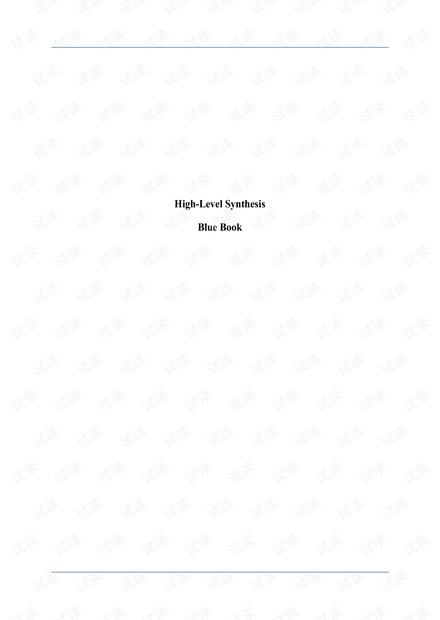High-Level Synthesis Blue Book
高级综合(High-Level Synthesis,简称HLS)是一种利用高级语言(如C++、SystemC)来描述硬件设计并自动生成硬件描述语言(如VHDL、Verilog)的过程。这种方法允许设计者从更抽象的层面上设计电子系统,从而提高设计效率,减少设计周期,并且可以使设计者将精力集中在算法的实现上,而不是具体的硬件细节上。 《High-Level Synthesis蓝皮书》作为一本专注于高级语言综合的经典教材,涵盖了高级综合的基本概念、工具使用、工作流程以及最佳实践等多方面的知识。本书所讨论的技术和内容是电子工程、数字系统设计等领域的研究者和工程师们在设计中不可或缺的一部分。 书中的内容广泛,既包括了理论知识,也强调了实践经验。对于初次接触HLS的读者,书中可能会先介绍一些简单的例子,例如一个用C++编写的有限冲激响应(FIR)滤波器,然后演示如何将该算法描述直接综合到寄存器传输级(RTL),这一步骤是HLS的关键所在。在此过程中,设计师能够体验到从高级语言描述生成多个具有不同面积/性能特性的RTL实现的惊人速度。这与传统的RTL设计方法相比,HLS能大幅缩短设计周期,提高设计灵活性。 随着对HLS工具和方法的理解逐渐深入,读者将开始尝试处理更复杂的电子系统设计。在这个阶段,他们将面临诸多挑战,如理解不同HLS工具之间的差异、学会如何有效地表达并综合算法到硬件,以及如何对综合后的结果进行验证。本书将会介绍一些高级话题,例如如何优化综合生成的RTL代码,以达到更好的性能或更小的面积占用,以及如何进行综合前后的设计验证。 此外,蓝皮书还可能会涉及一些关于HLS的高级特性,比如在高级综合中使用SystemC,这是一种将C++扩展以描述硬件行为的系统级建模语言。SystemC允许设计者在较高抽象层面上进行并行编程,对于复杂系统的设计尤为有用。 值得注意的是,虽然HLS有众多优点,但它也有其局限性和挑战。HLS生成的RTL代码可能并不总是完美无缺,设计师可能需要对生成的代码进行调整以满足特定的设计要求。因此,HLS设计师不仅需要掌握高级语言综合的技术知识,还需要有深入理解硬件结构和设计限制的能力。 蓝皮书的前言部分引用了滚石乐队(The Rolling Stones)的歌词,提示读者任何技术都不是万能的,而是应该根据具体情况来决定是否采用。书中还明确声明出版社和作者不对书中内容的准确性或完整性做出任何保证,也否认了对任何特定用途的适用性,这意味着设计师在采用书中建议的策略和建议时应谨慎,并且最好结合自己的实际情况来应用。 通过上述内容,我们不难看出,《High-Level Synthesis蓝皮书》不仅是一本技术参考书籍,更是工程师们在现代硬件设计领域的宝贵知识库。它在帮助工程师们理解HLS工作原理和实践应用的同时,也提醒他们注意技术应用的边界和责任。这本书对于那些渴望掌握高级语言综合技术的设计者来说,是一本不可或缺的学习资源。





剩余285页未读,继续阅读

- 粉丝: 0
 我的内容管理
展开
我的内容管理
展开
 我的资源
快来上传第一个资源
我的资源
快来上传第一个资源
 我的收益 登录查看自己的收益
我的收益 登录查看自己的收益 我的积分
登录查看自己的积分
我的积分
登录查看自己的积分
 我的C币
登录后查看C币余额
我的C币
登录后查看C币余额
 我的收藏
我的收藏  我的下载
我的下载  下载帮助
下载帮助

 前往需求广场,查看用户热搜
前往需求广场,查看用户热搜最新资源
- 基于plc的自动门控制系统论文.doc
- salvo-Rust资源
- 康通电子科技有限公司网络广播解决方案.doc
- 基于进化算法的约束多目标优化问题研究.doc
- 基于单片机的电力数据采集系统设计.pdf
- Python大作业源码小游戏-简单的滑雪游戏.zip
- 易利项目管理软件使用说明初学者用.doc
- 地铁信息系统集成简介.docx
- 教学网站设计与开发.doc
- 主成分分析及matlab实现.ppt
- 一页纸项目管理培训.pptx
- 项目管理附表模板.doc
- 网络情感日志模板【优秀9篇】.docx
- 江门项目管理知识定位分析报告.ppt
- 云计算行业就业分析策划方案.doc
- 罗克韦尔与西门子大型PLC通讯方案评析.doc


 信息提交成功
信息提交成功